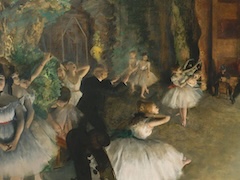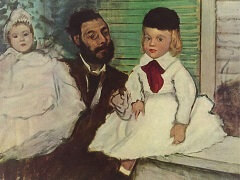The Curtain Falls, 1880 by Edgar Degas

Degas attempted nearly every moment in the ballet. This is the finale with the curtain coming down and cutting off the farther dancers, leaving only a glimpse of those in the front row. It is a perfect example of the artist's candid-camera eye and shows how, by catching and holding a moment, he was able to suggest suspended movement and generate in the beholder a desire to complete that movement.
The jostle of brilliant colors, exciting and unusual lighting - all the Impressionist vision of the scene is stabilized by the division of the picture into three unequal horizontal bands. Depth is cultivated by the shadowy recesses of the stage and by the three bows of the violins in the foreground which act as direction lines from the immediate foreground of the orchestra pit. In early theatre pictures Degas had emphasized the musicians in the bottom zone, contrasting their dark silhouettes with the luminous area of the stage. Here they are all but eliminated, yet manage to complete the scene and form a base for his composition. The pattern of crossed and jutting arms and legs is contrasted with the shimmering costumes of the ballet dancers. The sketchy strokes of pastel, the feathery surface, and sharp little accents of complementary color add to the picture's animation.
















